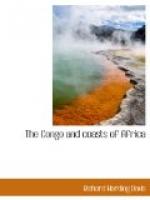As the Powers finally arranged it, the map of the West Coast is like a mosaic, like the edge of a badly constructed patchwork quilt. In trading along the West Coast a man can find use for five European languages, and he can use a new one at each port of call.
To the north, the West Coast begins with Cape Verde, which is Spanish. It is followed by Senegal, which is French; but into Senegal is tucked “a thin red line” of British territory called Gambia. Senegal closes in again around Gambia, and is at once blocked to the south by the three-cornered patch which belongs to Portugal. This is followed by French Guinea down to another British red spot, Sierra Leone, which meets Liberia, the republic of negro emigrants from the United States. South of Liberia is the French Ivory Coast, then the English Gold Coast; Togo, which is German; Dahomey, which is French; Lagos and Southern Nigeria, which again are English; Fernando Po, which is Spanish, and the German Cameroons.
The coast line of these protectorates and colonies gives no idea of the extent of their hinterland, which spreads back into the Sahara, the Niger basin, and the Soudan. Sierra Leone, one of the smallest of them, is as large as Maine; Liberia, where the emigrants still keep up the tradition of the United States by talking like end men, is as large as the State of New York; two other colonies, Senegal and Nigeria, together are 135,000 square miles larger than the combined square miles of all of our Atlantic States from Maine to Florida and including both. To partition finally among the Powers this strip of death and disease, of uncountable wealth, of unnamed horrors and cruelties, has taken many hundreds of years, has brought to the black man every misery that can be inflicted upon a human being, and to thousands of white men, death and degradation, or great wealth.




